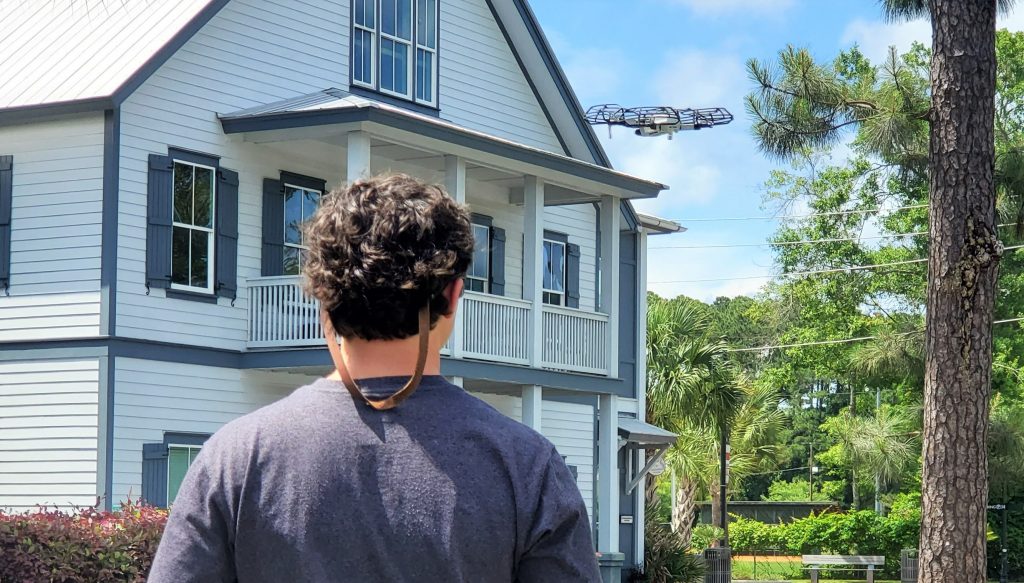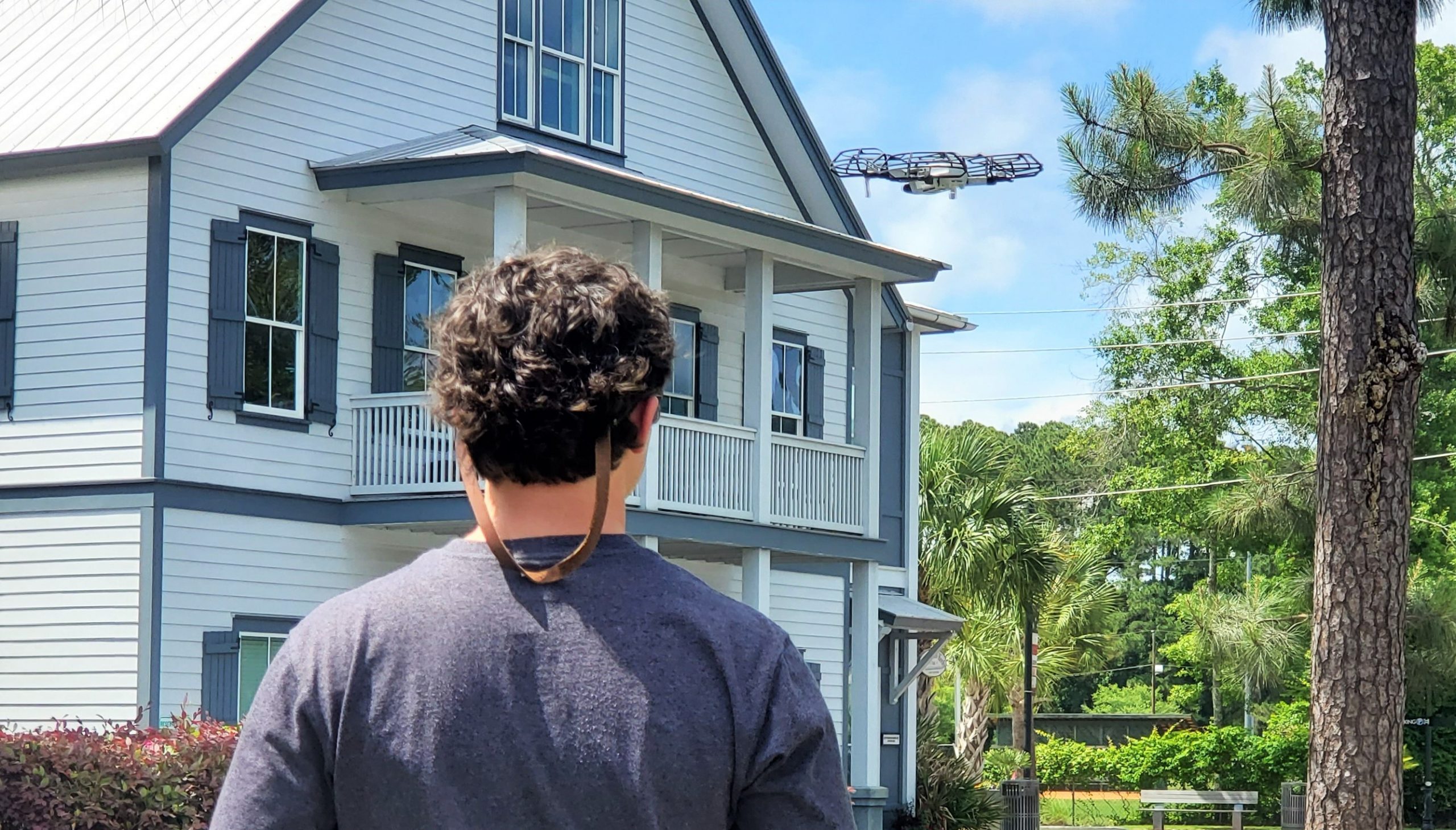Thinking of purchasing a “drone”1 for yourself or a family member this holiday season? Before you or your loved one rush out to take that first flight, there are a few big things you need to know. Following these tips can help you enjoy your new drone and help keep you or your loved one out of trouble with law enforcement or the Federal Aviation Administration (FAA).

First, do your homework. The cute little drone you may have purchased at a big box store is not a toy. It is an aircraft and is regulated by the FAA2. There are rule sets for recreational flying, commercial flying and public aircraft flying3. The rules for pilots flying drones (or unmanned aircraft) of all types outside your home can be a little complicated4. For simplicity, we’ll keep this discussion to the rules for drones weighing less than 55lbs for commercial and recreational flight. The similarities between rule sets are–DON’T FLY:
- beyond visual line of sight
- above 400 above the ground
- over people or moving cars
- in controlled airspace without a clearance (more on this later)
- at night in controlled airspace for recreational purposes.
- in a way that interferes with the flight or ground operation of any manned aircraft
- in a manner that endangers people or property
- without reading the drone operating manual or inspecting the drone prior to flight
- without the necessary training or certification
- without the required documents you must have with you when you fly
There is much more detail to all the above and some of the above can be waived but it is your responsibility to know and comply with all the rules for the type of flying you will do.
Basically, drones that weigh less than 55lbs, flown for other than recreational flight, fall under the 14 CFR Part 107 – Small Unmanned Aircraft Systems5 rule. This is the default rule set6, meaning that if you don’t fully meet all the conditions of the other rule sets, your flight will most likely be governed by this rule7. If you are flying just for fun, there is an exception to the Part 107 rule called the Exception for Limited Recreational Operations of Unmanned Flight8, more commonly known as “Section 44809.”Although much simpler, you must meet all the conditions of this rule in order to fly under this exception. If all this sounds confusing, the FAA has created a great starting point to help you figure out which rules apply to you here: https://www.faa.gov/uas/.9
Second, register your drone.
Pilots flying commercial drones weighing less than 55lbs under Part 107 must register10 each drone using either the FAA’s streamlined process at the Drone Zone website (https://faadronezone.faa.gov/) or using a paper registration process under Part 47. Unless you are flying outside the territories of the US, the streamlined process is the way to go. A unique registration number and certificate will be provided for each commercial drone registered and that unique registration number must be placed on the outside of the drone where it can be easily seen.
In contrast, pilots flying drones or model aircraft of all types under Section 44089 that weigh .55lbs (250 grams) or less, do not have to register their drone with the FAA. However, Section 44809 pilots flying drones or model aircraft weighing greater than .55lbs must register and mark their aircraft. Section 44809 pilots registering at the DroneZone will get one registration number and certificate for all the drones or model aircraft they fly. That same number will be placed on the outside of all recreational aircraft in a location that can be easily seen. You must be at least 13 years of age to register. Drone registrations cost $5 and are good for three years.
Third, get the certification (for Part 107) or training (for Section 44809) you need to legally fly. If you are flying for anything other than recreational purposes, you will need to have a Remote Pilot Certificate11 (aka a commercial drone license) from the FAA to fly under the Part 107 rule. Here, things get more complicated and a little more expensive. For a pilot new to aviation, a commercial drone license requires significant study, passing the initial FAA knowledge test (the cost is currently over $150) at a designated testing center and undergoing a Transportation Safety Agency background check (at no cost to you). Once both steps are successfully complete, you will be issued a Remote Pilot certificate.

Candidates for Remote Pilot certificates must be at least 16 years of age. Commercial drone pilots must have their Remote Pilot Certificate, a UAS drone registration certificate and a photo ID in their possession when flying. These documents must be available for law enforcement or FAA representatives to view. Other documents or special waivers may also be required. The Remote Pilot certificate is good for two years but recertification training is available online from the FAA at no cost.
If you are flying for recreational purposes under Section 44809, you must take The Recreational UAS Safety Test (TRUST)12. The test is really a combination of a safety training program and a test, so there is no need for any pre-study. TRUST is easy, it takes about 45 minutes to complete, there is no cost and you only have to complete this training/test one time. There is no minimum age limit to TRUST, so anyone who flys a drone recreationally must complete this requirement. CrossFlight Sky Solutions is a certified TRUST administrator, follow this link to get TRUST certified https://my.crossflightskysolutions.com/faa-trust/. When you complete TRUST, be sure to print out and keep your proof of completion in a safe place. You must have this document plus personal identification with you when you fly. You must be able to show either an electronic or a paper copy of the TRUST proof of completion to a law enforcement or an FAA representative if requested.
Fourth, know where and when it is ok to fly. Two major types of airspace (there are others) are uncontrolled and controlled airspace13. In uncontrolled airspace you may fly wherever and whenever you want as long as you follow the rules you are flying under and avoid any special airspace or sensitive areas14. In controlled airspace, you must have a specific authorization from the FAA to fly. Controlled airspace can be anywhere, but usually it is near larger metropolitan airports. Your neighborhood and your house can even be in controlled airspace and it can start at ground level. Whether you are flying under Part 107 or Section 44809 rules, if you are in controlled airspace, you must have an FAA clearance to fly. How do you know if you are in controlled airspace? Like so many other issues in our lives today, “there’s an app for that.” It’s called B4UFLY15. Here you can see what kind of airspace you are in and if it’s ok to fly where you are. If you need a flight authorization to access controlled airspace, you can file an authorization request using the Low Altitude Authorization and Notification Capability (LAANC)16 system by downloading and installing any one of several apps from an FAA Approved LAANC UAS Service Supplier.
Fifth, keep up with the rules. A lot has happened in the drone world since Congress directed the FAA to integrate drones (Unmanned Aircraft Systems) into the National Airspace System17 in 2012 and a lot more is planned. New rules on Remote Identification18 and flight Operations Over People19 have already been published. Some of these rules are in effect now and some will take effect by September of 2023.
For those interested in learning more about commercial flight under Part 107, download and read FAA Advisory Circular 107-2A.20 For those interested in learning more recreational flight under Section 44809, download and read FAA Advisory Circular 91-57B21 and it’s pending replacement, FAA Advisory Circular 91-57C22. Also, consider taking professional hands-on flight training from CrossFlight Sky Solutions23 or another experienced and reputable company. Lastly, joining a Remote Control (RC) recreational flying club in your local area is a great way to enjoy your new aviation interest. Most of the pilots in these clubs are passionate about RC aircraft flying and many clubs have an outstanding location to fly for a nominal membership fee.
The final tip–know that failure to follow the rules for drones can result in either civil or criminal penalties or both. Endangering the National Airspace System is serious business. There are many airspace restrictions24 in both controlled and uncontrolled airspace. Inadvertently entering any of these areas with a drone may lead to enforcement actions25 that could be very costly.
The tips provided above will get you off to a good start but there is much, much more to learn about flying unmanned aircraft in the National Airspace System. This is an exciting time in the drone industry as a whole and parents who invest the money and time to safely and responsibility introduce their loved one to unmanned aircraft systems may spark a career that will last a lifetime. In the commercial drone segment alone the “…FAA forecasts that the commercial UAS fleet by 2025 will likely…be at around 835,000; 1.7 times larger than the current number of commercial sUAS….”26 Learn the rules, fly responsibly and have fun.
1Also known as an Unmanned Aircraft (UA). A UA plus its flight controller is an Unmanned Aircraft System (UAS).
2“LAW ENFORCEMENT GUIDANCE FOR SUSPECTED … – FAA.” https://www.faa.gov/uas/resources/policy_library/media/FAA_UAS-PO_LEA_Guidance.pdf. Accessed 22 Dec. 2021.
3Public aircraft operations include law enforcement, firefighting, etc.
4The FAA does not regulate flight in your home but some states do regulate indoor flight.
5“14 CFR Part 107 — Small Unmanned Aircraft Systems – eCFR.” https://www.ecfr.gov/current/title-14/chapter-I/subchapter-F/part-107. Accessed 21 Dec. 2021.
6“Recreational Flyers & Modeler Community-Based Organizations.” 2 Sep. 2021, https://www.faa.gov/uas/recreational_fliers/. Accessed 21 Dec. 2021.
7An example of an exception to this general rule would be if your drone weighed more than 55 lbs.
8“Exception for Limited Recreational Operations of Unmanned Aircraft.” 17 May. 2019, https://www.federalregister.gov/documents/201905/17/2019-10169/exception-for-limited-recreational-operations-of-unmanned-aircraft. Accessed 21 Dec. 2021.
9“Unmanned Aircraft Systems (UAS) – Federal Aviation Administration.” 20 Sep. 2021, https://www.faa.gov/uas/. Accessed 21 Dec. 2021.
10“Aircraft Registration – Unmanned Aircraft (UA) – Federal Aviation ….” 18 Aug. 2021, https://www.faa.gov/licenses_certificates/aircraft_certification/aircraft_registry/UA/. Accessed 22 Dec. 2021.
11“Become a Drone Pilot – Federal Aviation Administration.” 19 May. 2021, https://www.faa.gov/uas/commercial_operators/become_a_drone_pilot/. Accessed 21 Dec. 2021.
12“The Recreational UAS Safety Test (TRUST) – Federal Aviation ….” 13 Sep. 2021, https://www.faa.gov/uas/recreational_fliers/knowledge_test_updates/. Accessed 21 Dec. 2021.
13 “Chapter 15: Airspace – Federal Aviation Administration.” https://www.faa.gov/regulations_policies/handbooks_manuals/aviation/phak/media/17_phak_ch15.pdf. Accessed 21 Dec. 2021.
14Some states regulate takeoff and landing areas. Night flying requires anti-collision lights capable of being seen at least 3 statute miles away. Commercial night flight requires certification training. Recreational pilots may not fly at night in controlled airspace.
15 “B4UFLY Mobile App – Federal Aviation Administration.” 2 Jun. 2021, https://www.faa.gov/uas/recreational_fliers/where_can_i_fly/b4ufly/. Accessed 21 Dec. 2021.
16“UAS Data Exchange (LAANC) – Federal Aviation Administration.” 18 Nov. 2021, https://www.faa.gov/uas/programs_partnerships/data_exchange/. Accessed 21 Dec. 2021.
17“Third Edition – Integration of Civil UAS in the NAS – Federal Aviation ….” https://www.faa.gov/uas/resources/policy_library/media/2019_UAS_Civil_Integration_Roadmap_third_edition.pdf. Accessed 21 Dec. 2021.
18 “UAS Remote Identification Overview – Federal Aviation Administration.” 13 Oct. 2021, https://www.faa.gov/uas/getting_started/remote_id/. Accessed 21 Dec. 2021.
19“Operations Over People General Overview – Federal Aviation ….” 17 Nov. 2021, https://www.faa.gov/uas/commercial_operators/operations_over_people/. Accessed 21 Dec. 2021.
20“AC 107-2A – Small Unmanned Aircraft System (Small UAS) – Federal ….” 1 Feb. 2021, https://www.faa.gov/regulations_policies/advisory_circulars/index.cfm/go/document.information/documentID/1038977. Accessed 21 Dec. 2021.
21“AC 91-57B – Exception for Limited Recreational Operations of ….” 31 May. 2019, https://www.faa.gov/regulations_policies/advisory_circulars/index.cfm/go/document.information/documentID/1036029. Accessed 21 Dec. 2021.
22 “FAA Releases Draft AC 91-57C – AMA IN ACTION Advocating for ….” 15 Jul. 2021, https://amablog.modelaircraft.org/amagov/2021/07/15/faa-releases-draft-ac-91-57c/. Accessed 21 Dec. 2021.
23“Services-Education-Training – CrossFlight Sky Solutions.” https://crossflightskysolutions.com/drone-education-training/. Accessed 21 Dec. 2021.
24“Airspace Restrictions – Federal Aviation Administration.” 16 Jul. 2020, https://www.faa.gov/uas/recreational_fliers/where_can_i_fly/airspace_restrictions/. Accessed 21 Dec. 2021.
25 “FAA Targets UAS Violators for Enforcement.” 28 Sep. 2018, https://www.faa.gov/newsroom/faa-targets-uas-violators-enforcement. Accessed 21 Dec. 2021.
26“FAA Aerospace Forecasts.” 6 Jul. 2021, https://www.faa.gov/data_research/aviation/aerospace_forecasts/. Accessed 22 Dec. 2021.
